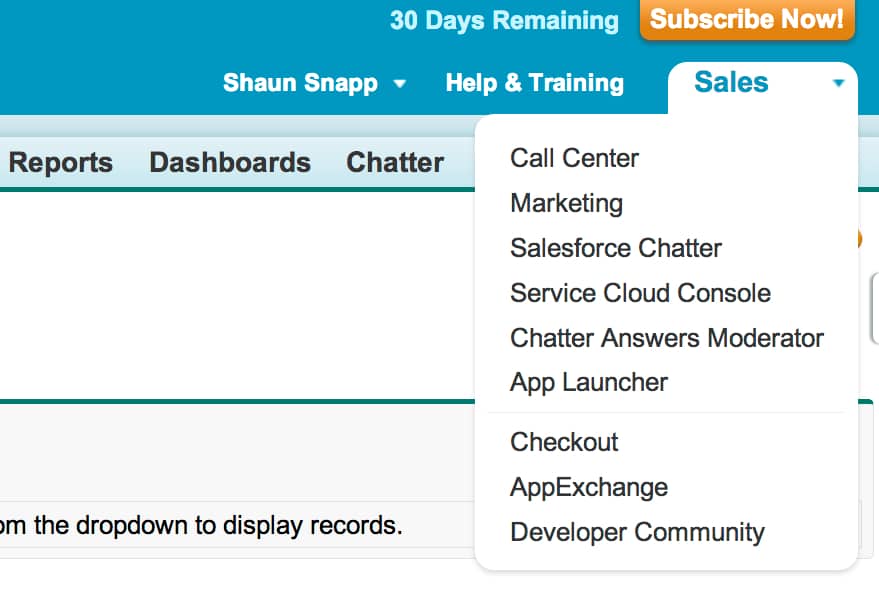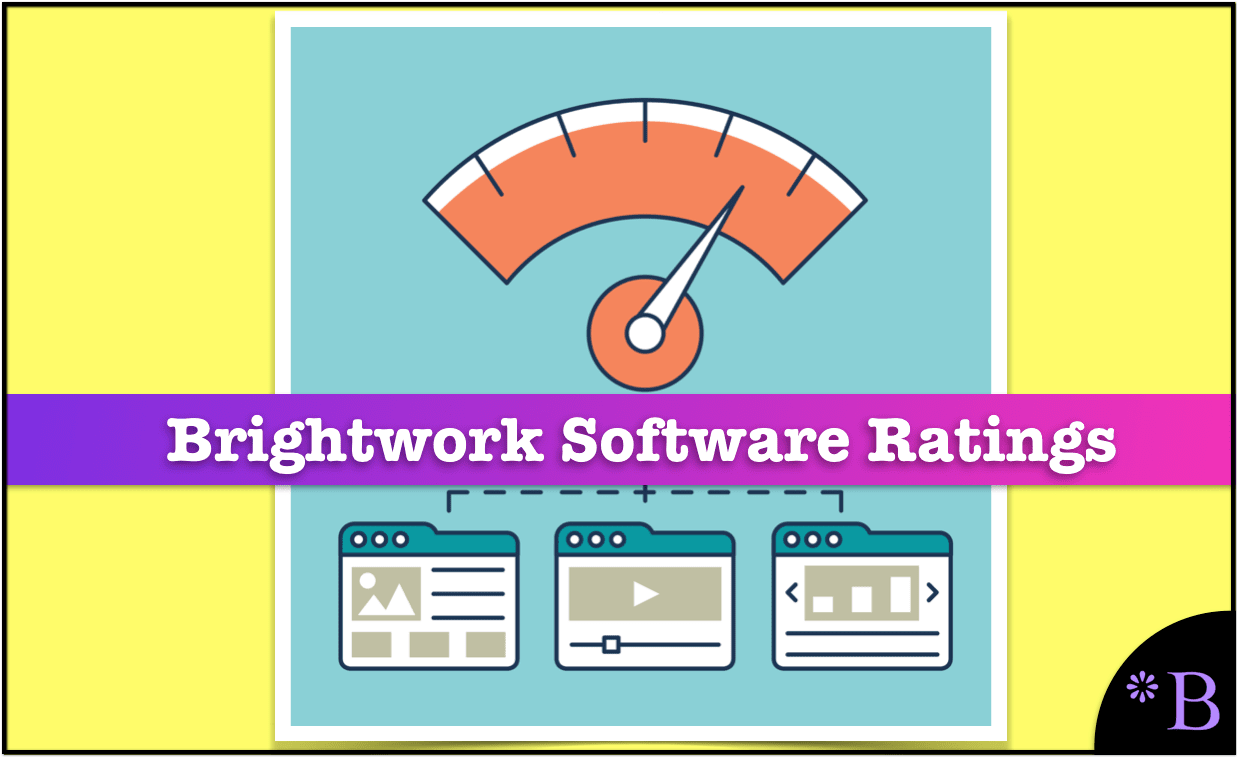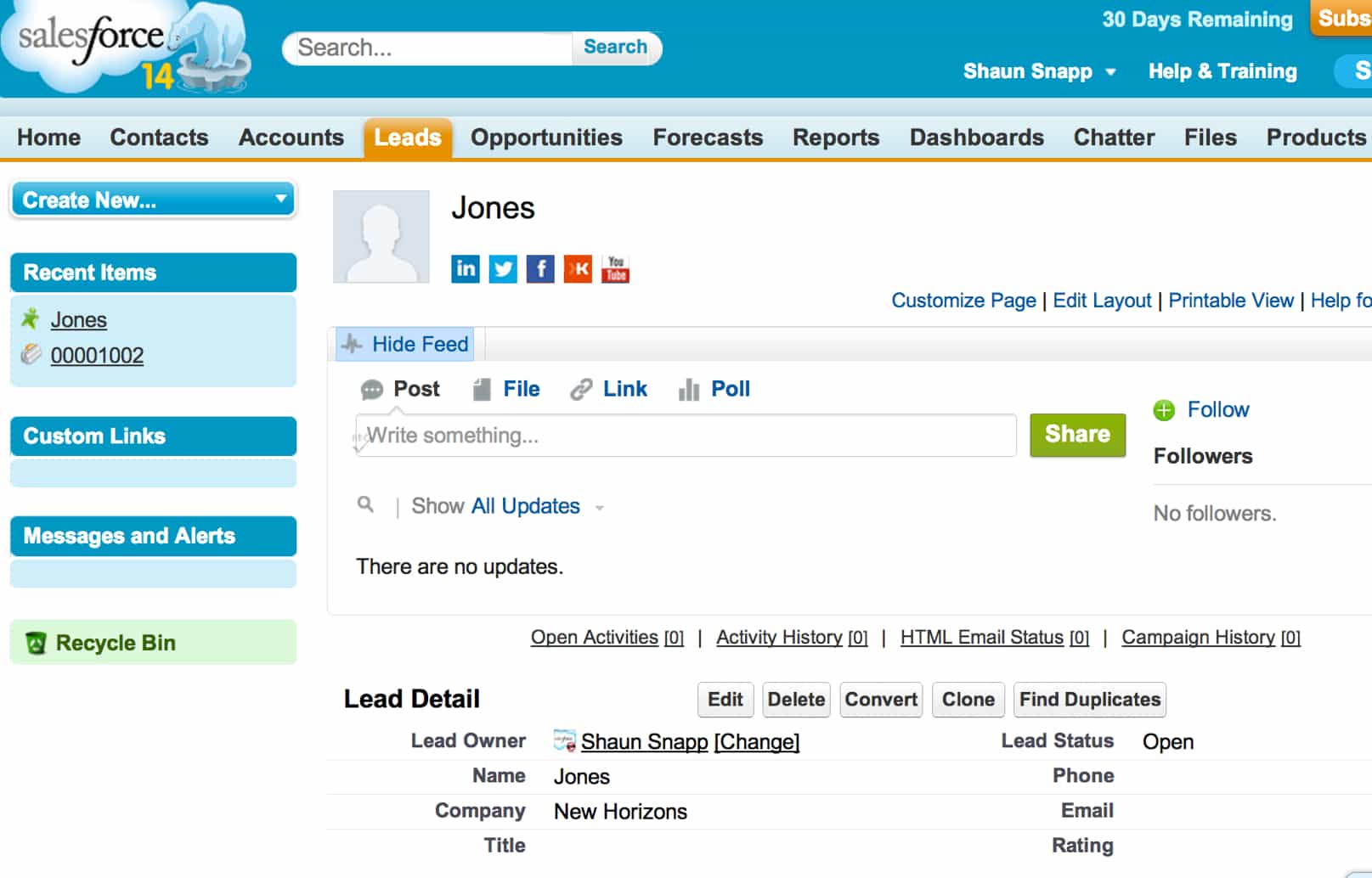Executive Summary
- This is the Brightwork Research & Analysis software rating series.
- We rate both the software and estimate the risk of implementing each application.
MUFI Rating & Risk for Salesforce Enterprise
MUFI: Maintainability, Usability, Functionality, Implement ability
Vendor: Salesforce (Select For Vendor Profile)
Introduction
Salesforce is one of the most interesting software vendors that we cover. Siebel was the early originator of CRM, but Salesforce has redefined the category as well as make it viable, and it seems like Salesforce is just getting started. Although there are questions how much Salesforce wants to focus on continuing to develop its CRM and other customer-oriented applications, and how much it wants to focus on being a platform provider. Salesforce CRM has a high buyer satisfaction level.
Application Detail
Salesforce is the functionality leader in the CRM market, but CRM applications are the simplest of any enterprise software category that we cover – so even having the most functionality, Salesforce is still a simple application. Once Salesforce is purchased by a client the application is “sticky,” in that its customers tend to stay with Salesforce. To us the Salesforce user interface is overly simple with too little information on each screen.
Salesforce CRM has rather basic functionality. It is an input-output application, which lacks processing logic that is usually part of enterprise software. CRM is a simple application, and it should cost less than any of the other software categories that we cover. And in fact, that tends to be true, except for the lowest cost ERP systems, which CRM systems have a higher TCO versus.
And we question the efficiency of Salesforce CRM as it takes quite a few screens to get to the final goal. The simplicity and even the colors of the user interface make it look like the application is directed towards the children’s market, and all of the Salesforce’s applications look and work the same way. However, its hard to argue with success as the user response to Salesforce CRM’s user interface is quite positive – indicating that Salesforce knows its users at lot better than we do. In fact, we can see areas of the user interface that have quite clearly been copied by other CRM vendors.
Salesforce offers a mainline CRM application and is sometimes criticized for not having good marketing platform functionality – however, CRM is in flux regarding its direction, making it increasingly difficult to say definitively what the scope of what is a CRM system. In fact, we question how valuable the term CRM will be in the future – as it has degenerated into a catch-all term for a variety of customer-related applications. For instance, Salesforce is strong in call center functionality – called Service Cloud, however, that is a separate software category. We predict that CRM will break into several software categories, with different software vendors leading each of these categories. One, of course, is already well developed, called marketing automation – whose leading software vendors are not the same software vendors that are leaders in CRM.
 Something Salesforce is excellent at is allowing any of the applications that are part of their platform be easily installed. This is more of a contribution to enterprise software than the original Salesforce CRM application.
Something Salesforce is excellent at is allowing any of the applications that are part of their platform be easily installed. This is more of a contribution to enterprise software than the original Salesforce CRM application.
Of course, the Salesforce CRM application is just the beginning, with AppExchange being a big part of any analysis of Salesforce. Bluewolf reports that 91% of Salesforce customers have at least 1 AppExchange application installed, and 29% have at least five installed. Salesforce is morphing into something far beyond merely CRM. Salesforce allows for the creation of private communities for collaboration. Salesforce is showing great creativity in allowing the integration of applications in many different areas to integrate to it. Salesforce’s Force.com platform not only positions Salesforce CRM for fast integration with AppExchange partners, but Salesforce’s infrastructure and integration capabilities are some of the strongest in enterprise software – and this allows Salesforce CRM to integrated quickly and efficiently to other non-Force.com applications. Interestingly, integrations to other applications on the AppExchange are not as complete as most customers are lead to believe. We hesitate to call the provided integration a starter kit, but in many cases, additional integration will be required.
The next stage of CRM is to add marketing platform functionality as well, and this is not a strength for Salesforce.
Unfortunately, Salesforce is now so established that the primary consulting companies have built up skills and Salesforce has partnerships with all of them. This means that Salesforce implementations are becoming more lengthy and costing more, increasing the TCO of Salesforce CRM. The major consulting companies will not tolerate fast implementations that are good value for clients, and so get ready for Salesforce implementations to be much more about “process” and uses the term “best practices.”
Salesforce is one of the few enterprise software vendors with substantially higher prices for non-US customers. Our TCO for Salesforce Enterprise estimates TCO for US customers. For non-US customers, we can estimate a TCO for your region.
While Salesforce should be applauded for price transparency as they publish their prices on their website, our TCO analysis shows that its costs add up to a TCO that is surprisingly high when just looking at the initial costs of acquisition. Salesforce is now the highest cost CRM application, by initial license cost of any application in the CRM market.
MUFI Scores
All scores out of a possible 10.
MUFI Scores
- Ma. = Maintainability
- Us. = Usability
- Fu. = Functionality
- Im. = Implementability
| App | Ma. | Us. | Ft. | Im. | Cat. |
|---|---|---|---|---|---|
| Average Score for Big ERP | 5.1 | 4.8 | 5.2 | 5.4 | Big ERP |
| Average Score for CRM | 6.2 | 6.2 | 5.1 | 5.9 | CRM |
| Average Score for Small and Medium ERP | 8.3 | 8 | 6.7 | 8.5 | Small and Medium ERP |
| Average Score for Finance | 8.8 | 8.8 | 8 | 8.8 | Finance |
| Average Score for Demand Planning | 7.6 | 7.2 | 7 | 7.1 | Demand Planning |
| Average Score for Supply Planning | 6.7 | 6.9 | 7 | 6.8 | Supply Planning |
| Average Score for Production Planning | 6.8 | 6.9 | 7 | 6.9 | Production Planning |
| Average Score for BI Heavy | 5.5 | 5.3 | 6.9 | 5.3 | BI Heavy |
| Average Score for PLM | 7 | 7.2 | 6.8 | 7.3 | PLM |
| Average Score for BI Light | 7.7 | 8.7 | 9 | 8.3 | BI Light |
| Arena Solutions Arena PLM | 10 | 10 | 10 | 10 | PLM |
| AspenTech AspenOne | 4 | 8 | 10 | 7 | Production Planning |
| Birst | 8 | 8.5 | 10 | 8 | BI Light |
| ERPNext | 10 | 10 | 7.5 | 10 | Small and Medium ERP |
| Delfoi Planner | 8 | 6 | 6.5 | 7 | Production Planning |
| Demand Works Smoothie SP | 9 | 10 | 7 | 10 | Supply Planning |
| Hamilton Grant RM | 10 | 9 | 8.5 | 9 | PLM |
| IBM Cognos | 2.7 | 3 | 1.5 | 3 | BI Heavy |
| Infor Epiphany | 7 | 8 | 6 | 5 | CRM |
| Infor Lawson | 8 | 7 | 6 | 7 | Big ERP |
| Intuit QuickBooks Enterprise Solutions | 9 | 9 | 5 | 9 | Finance |
| JDA DM | 9 | 7.5 | 8 | 8 | Demand Planning |
| Microsoft Dynamics CRM | 2 | 3 | 2 | 2 | CRM |
| NetSuite CRM | 6 | 4 | 3 | 3 | CRM |
| Netsuite OneWorld | 7 | 7 | 8 | 8 | Big ERP |
| OpenERP | 7 | 8 | 8.5 | 8 | 7 |
| Oracle BI | 4 | 4 | 3 | 6 | BI Heavy |
| Oracle CRM On Demand | 4 | 5 | 3 | 5 | CRM |
| Oracle Demantra | 5 | 3 | 3.5 | 4.5 | Demand Planning |
| Oracle JD Edwards World | 4 | 1 | 3 | 6 | Big ERP |
| Oracle RightNow | 6 | 7 | 4 | 5 | CRM |
| PlanetTogether Galaxy APS | 10 | 10 | 10 | 10 | Production Planning |
| Preactor | 8 | 7 | 3 | 7 | Production Planning |
| QlikTech QlikView | 9 | 9 | 10 | 9 | BI Light |
| Rootstock | 9 | 8 | 9 | 9 | Small and Medium ERP |
| Sage X3 | 8 | 8 | 7 | 8 | Big ERP |
| Salesforce Enterprise | 8 | 8.5 | 9 | 7.5 | CRM |
| SAP APO DP | 3 | 4 | 3 | 2 | Demand Planning |
| SAP APO PP/DS | 2 | 2 | 4 | 3 | Production Planning |
| SAP APO SNP | 3 | 4 | 8 | 4 | Supply Planning |
| SAP BI/BW | 1.5 | 2 | 4 | 2 | BI Heavy |
| SAP Business Objects | 3 | 2.5 | 7 | 3 | BI Heavy |
| SAP CRM | 4 | 3 | 6 | 4 | CRM |
| SAP ECC | 3 | 3 | 6.5 | 3 | Big ERP |
| SAP PLM | 1 | 2.5 | 2 | 3 | PLM |
| SAP SmartOps | 4 | 4 | 7 | 5.5 | Supply Planning |
| SAS BI | 6.5 | 7 | 9 | 6 | BI Heavy |
| SAS Demand Driven Forecasting | 7 | 8 | 9 | 7 | Demand Planning |
| Tableau (BI) | 9 | 10 | 10 | 10 | BI Light |
| Tableau (Forecasting) | 10 | 8 | 5 | 9 | Demand Planning |
| Teradata | 8 | 6.3 | 9.7 | 6 | BI Heavy |
| ToolsGroup SO99 (Forecasting) | 7 | 8 | 9 | 7 | Demand Planning |
| ToolsGroup SO99 (Supply) | 5 | 6 | 10 | 7 | Supply Planning |
Vendor and Application Risk
Salesforce Enterprise provides a fairly smooth ability to implement its application. Because Salesforce Enterprise has a user interface that is well liked, user adoption is in the buyer’s favor.
Likelihood of Implementation Success
This accounts for both the application and vendor-specific risk. In our formula, the total implementation risk is application + vendor + buyer risk. The buyer specific risk could increase or decrease this overall likelihood and adjust the values that you see below.
Likelihood of Application Implementation Success and Failure
Search for the application in this table using the search bar in the upper right of the table.
| Application | Prob of Implementation Success | Prob of Implementation Failure |
|---|---|---|
| Actuate | 0.77 | 0.23 |
| SAP Smartops | 0.39 | 0.61 |
| NetSuite CRM | 0.46 | 0.54 |
| Sugar CRM | 0.62 | 0.48 |
| Base CRM | 0.91 | 0.09 |
| SAP CRM | 0.35 | 0.65 |
| Salesforce Enterprise | 0.72 | 0.28 |
| QlikTech QlikView | 0.82 | 0.18 |
| Tableau (BI) | 0.98 | 0.02 |
| SAP Crystal Reports | 0.46 | 0.54 |
| Brist | 0.83 | 0.17 |
| MicroStrategy | 0.7 | 0.3 |
| SAS BI | 0.76 | 0.24 |
| Oracle BI | 0.35 | 0.65 |
| IBM Cognos | 0.23 | 0.77 |
| Infor Epiphany | 0.58 | 0.42 |
| Microsoft Dynamics CRM | 0.26 | 0.74 |
| Oracle RightNow CRM | 0.41 | 0.59 |
| Oracle CRM On Demand | 0.36 | 0.64 |
| Teradata | 0.76 | 0.24 |
| SAP Business Objects | 0.32 | 0.68 |
| SAP BI/BW | 0.25 | 0.75 |
| SAP PLM | 0.29 | 0.71 |
| Hamilton Grant RM | 0.89 | 0.11 |
| Arena Solutions | 0.96 | 0.04 |
| Delfoi Planner | 0.7 | 0.3 |
| Preactor | 0.64 | 0.36 |
| PlanetTogether Galaxy APS | 0.96 | 0.04 |
| AspenTech AspenOne | 0.55 | 0.45 |
| SAP APO PP/DS | 0.27 | 0.73 |
| Demand Works Smoothie SP | 0.93 | 0.07 |
| ToolsGroup SO99 (Supply) | 0.82 | 0.18 |
| Demand Works Smoothie | 0.96 | 0.04 |
| Tableau (Forecasting) | 0.9 | 0.1 |
| SAS Demand Driven Forecasting | 0.82 | 0.18 |
| ToolsGroup SO99 (Forecasting) | 0.86 | 0.14 |
| JDA DM | 0.57 | 0.43 |
| Oracle Demantra | 0.33 | 0.67 |
| SAP APO DP | 0.28 | 0.72 |
| FinancialForce | 0.92 | 0.08 |
| Intacct | 0.98 | 0.02 |
| Intuit QB Enterprise | 0.8 | 0.2 |
| ERPNext | 0.9 | 0.1 |
| OpenERP | 0.78 | 0.22 |
| Rootstock | 0.91 | 0.09 |
| ProcessPro | 0.93 | 0.07 |
| Microsoft Dynamics AX | 0.4 | 0.6 |
| SAP Business One | 0.49 | 0.51 |
| Sage X3 | 0.62 | 0.38 |
| Infor Lawson | 0.58 | 0.42 |
| Epicor ERP | 0.4 | 0.6 |
| Oracle JD Edwards World | 0.31 | 0.69 |
| Oracle JD Edwards EnterpriseOne | 0.36 | 0.64 |
| SAP ERP ECC/R/3 | 0.32 | 0.68 |
| NetSuite OneWorld | 0.65 | 0.35 |
Risk Definition
See this link for more on our categorizations of risk. We also offer a Buyer Specific Risk Estimation as a service for those that want a comprehensive analysis.
Risk Management Approach
There are no special considerations regarding risk management for Salesforce Enterprise implementations.
Finished With Your Analysis?
To go back to the Software Selection Package page for the CRM software category. Or goto this link to see other analytical products for Salesforce Enterprise.
References
https://www.bluewolf.com/assetdownload/hidden/Bluewolf_StateofSalesforceReport13.pdf

